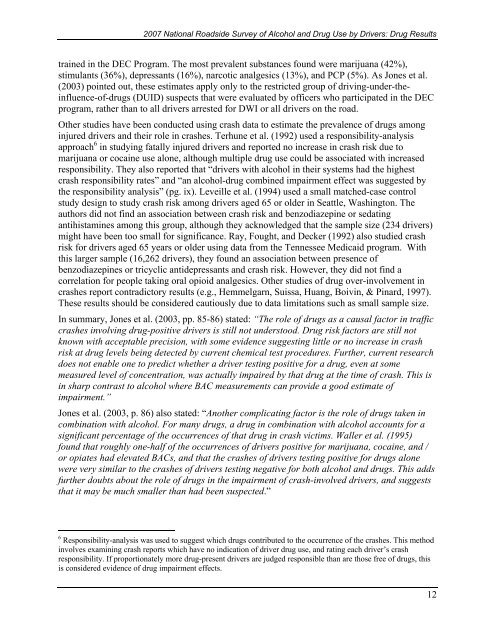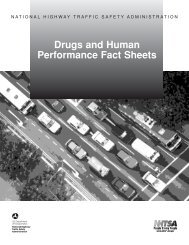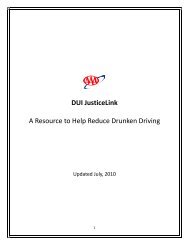2007 National Roadside Survey of Alcohol and Drug Use by Drivers
2007 National Roadside Survey of Alcohol and Drug Use by Drivers
2007 National Roadside Survey of Alcohol and Drug Use by Drivers
Create successful ePaper yourself
Turn your PDF publications into a flip-book with our unique Google optimized e-Paper software.
<strong>2007</strong> <strong>National</strong> <strong>Roadside</strong> <strong>Survey</strong> <strong>of</strong> <strong>Alcohol</strong> <strong>and</strong> <strong>Drug</strong> <strong>Use</strong> <strong>by</strong> <strong>Drivers</strong>: <strong>Drug</strong> Resultstrained in the DEC Program. The most prevalent substances found were marijuana (42%),stimulants (36%), depressants (16%), narcotic analgesics (13%), <strong>and</strong> PCP (5%). As Jones et al.(2003) pointed out, these estimates apply only to the restricted group <strong>of</strong> driving-under-theinfluence-<strong>of</strong>-drugs(DUID) suspects that were evaluated <strong>by</strong> <strong>of</strong>ficers who participated in the DECprogram, rather than to all drivers arrested for DWI or all drivers on the road.Other studies have been conducted using crash data to estimate the prevalence <strong>of</strong> drugs amonginjured drivers <strong>and</strong> their role in crashes. Terhune et al. (1992) used a responsibility-analysisapproach 6 in studying fatally injured drivers <strong>and</strong> reported no increase in crash risk due tomarijuana or cocaine use alone, although multiple drug use could be associated with increasedresponsibility. They also reported that “drivers with alcohol in their systems had the highestcrash responsibility rates” <strong>and</strong> “an alcohol-drug combined impairment effect was suggested <strong>by</strong>the responsibility analysis” (pg. ix). Leveille et al. (1994) used a small matched-case controlstudy design to study crash risk among drivers aged 65 or older in Seattle, Washington. Theauthors did not find an association between crash risk <strong>and</strong> benzodiazepine or sedatingantihistamines among this group, although they acknowledged that the sample size (234 drivers)might have been too small for significance. Ray, Fought, <strong>and</strong> Decker (1992) also studied crashrisk for drivers aged 65 years or older using data from the Tennessee Medicaid program. Withthis larger sample (16,262 drivers), they found an association between presence <strong>of</strong>benzodiazepines or tricyclic antidepressants <strong>and</strong> crash risk. However, they did not find acorrelation for people taking oral opioid analgesics. Other studies <strong>of</strong> drug over-involvement incrashes report contradictory results (e.g., Hemmelgarn, Suissa, Huang, Boivin, & Pinard, 1997).These results should be considered cautiously due to data limitations such as small sample size.In summary, Jones et al. (2003, pp. 85-86) stated: “The role <strong>of</strong> drugs as a causal factor in trafficcrashes involving drug-positive drivers is still not understood. <strong>Drug</strong> risk factors are still notknown with acceptable precision, with some evidence suggesting little or no increase in crashrisk at drug levels being detected <strong>by</strong> current chemical test procedures. Further, current researchdoes not enable one to predict whether a driver testing positive for a drug, even at somemeasured level <strong>of</strong> concentration, was actually impaired <strong>by</strong> that drug at the time <strong>of</strong> crash. This isin sharp contrast to alcohol where BAC measurements can provide a good estimate <strong>of</strong>impairment.”Jones et al. (2003, p. 86) also stated: “Another complicating factor is the role <strong>of</strong> drugs taken incombination with alcohol. For many drugs, a drug in combination with alcohol accounts for asignificant percentage <strong>of</strong> the occurrences <strong>of</strong> that drug in crash victims. Waller et al. (1995)found that roughly one-half <strong>of</strong> the occurrences <strong>of</strong> drivers positive for marijuana, cocaine, <strong>and</strong> /or opiates had elevated BACs, <strong>and</strong> that the crashes <strong>of</strong> drivers testing positive for drugs alonewere very similar to the crashes <strong>of</strong> drivers testing negative for both alcohol <strong>and</strong> drugs. This addsfurther doubts about the role <strong>of</strong> drugs in the impairment <strong>of</strong> crash-involved drivers, <strong>and</strong> suggeststhat it may be much smaller than had been suspected.”6 Responsibility-analysis was used to suggest which drugs contributed to the occurrence <strong>of</strong> the crashes. This methodinvolves examining crash reports which have no indication <strong>of</strong> driver drug use, <strong>and</strong> rating each driver’s crashresponsibility. If proportionately more drug-present drivers are judged responsible than are those free <strong>of</strong> drugs, thisis considered evidence <strong>of</strong> drug impairment effects.12




